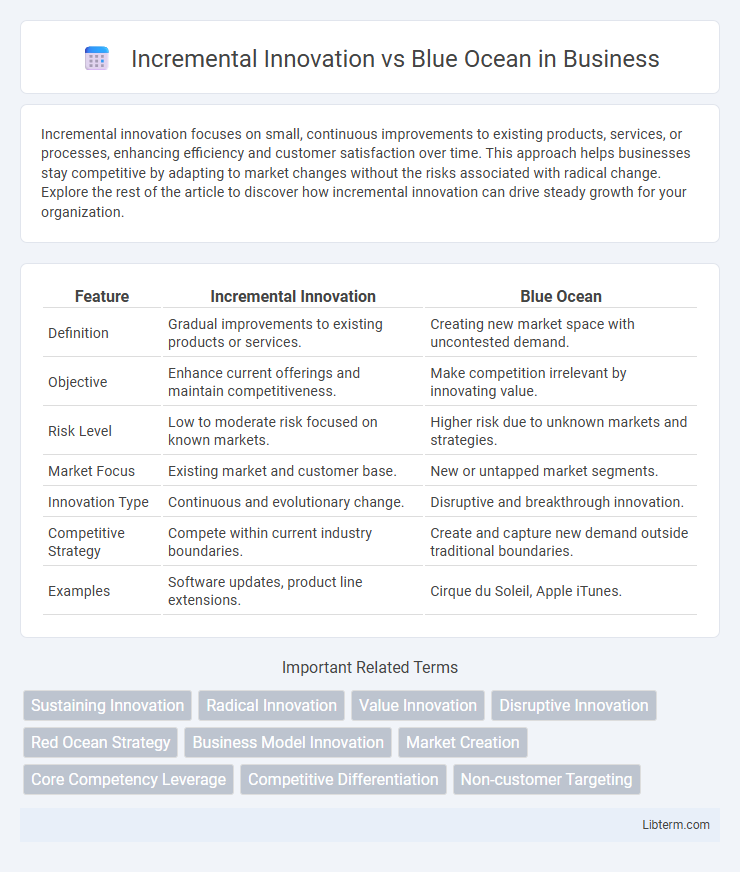Incremental innovation focuses on small, continuous improvements to existing products, services, or processes, enhancing efficiency and customer satisfaction over time. This approach helps businesses stay competitive by adapting to market changes without the risks associated with radical change. Explore the rest of the article to discover how incremental innovation can drive steady growth for your organization.
Table of Comparison
| Feature | Incremental Innovation | Blue Ocean |
|---|---|---|
| Definition | Gradual improvements to existing products or services. | Creating new market space with uncontested demand. |
| Objective | Enhance current offerings and maintain competitiveness. | Make competition irrelevant by innovating value. |
| Risk Level | Low to moderate risk focused on known markets. | Higher risk due to unknown markets and strategies. |
| Market Focus | Existing market and customer base. | New or untapped market segments. |
| Innovation Type | Continuous and evolutionary change. | Disruptive and breakthrough innovation. |
| Competitive Strategy | Compete within current industry boundaries. | Create and capture new demand outside traditional boundaries. |
| Examples | Software updates, product line extensions. | Cirque du Soleil, Apple iTunes. |
Understanding Incremental Innovation
Incremental innovation involves making small, continuous improvements to existing products, services, or processes, enhancing efficiency and customer satisfaction over time. This approach leverages existing market knowledge, reduces risk, and supports steady growth by refining current offerings rather than creating entirely new ones. Businesses focusing on incremental innovation often prioritize customer feedback and iterative development to maintain competitive advantage within established market boundaries.
Defining Blue Ocean Strategy
Blue Ocean Strategy focuses on creating uncontested market space by innovating value to make the competition irrelevant, rather than competing in existing markets through incremental improvements. It emphasizes differentiation and low cost simultaneously, leading to new demand creation and breaking away from traditional industry boundaries. This approach contrasts with incremental innovation, which seeks continuous, small-scale enhancements within established market parameters.
Key Differences Between Incremental Innovation and Blue Ocean
Incremental innovation improves existing products or services by making small, continuous enhancements, targeting current markets and customer needs. Blue Ocean strategy creates entirely new market spaces by introducing disruptive innovations that render competition irrelevant, focusing on value innovation and differentiation. Key differences include the scope of change, with incremental innovation optimizing within existing frameworks, while blue ocean innovation breaks boundaries to unlock untapped demand.
Benefits of Incremental Innovation
Incremental innovation drives steady growth by continuously improving existing products, services, and processes, leading to enhanced customer satisfaction and operational efficiency. It minimizes risks and investment costs compared to radical changes, ensuring sustainable competitive advantage within current markets. Companies leveraging incremental innovation can quickly adapt to market feedback while maintaining stable revenue streams.
Advantages of Blue Ocean Strategy
Blue Ocean Strategy offers significant advantages by creating uncontested market space, enabling companies to evade intense competition and achieve rapid growth. It emphasizes value innovation, which simultaneously reduces costs and increases buyer value, leading to strong differentiation and customer loyalty. This approach encourages breakthrough products and services that unlock new demand, fostering sustainable profitability and long-term strategic positioning.
Risks and Limitations of Incremental Innovation
Incremental innovation involves gradual improvements to existing products or processes, often minimizing risks but limiting breakthroughs and market disruption opportunities. The primary risk lies in its potential to be outpaced by competitors adopting radical innovations, resulting in missed chances for significant growth. Incremental innovation can lead to stagnation, as it maintains the status quo and struggles to create new market spaces unlike Blue Ocean strategies.
Challenges in Executing Blue Ocean Strategies
Executing Blue Ocean strategies presents distinct challenges such as identifying uncontested market spaces that truly offer new demand without heavy competition. Companies often struggle with resource allocation since Blue Ocean initiatives require significant investment in innovation and market research, unlike incremental innovation which builds on existing capabilities. The uncertainty and risk linked with pioneering uncharted territories frequently hinder commitment from stakeholders accustomed to the predictability of incremental improvements.
When to Choose Incremental Innovation
Incremental innovation is most effective when a company operates in a mature market with established customer preferences and seeks to improve existing products or processes to enhance competitiveness and efficiency. This approach minimizes risk by leveraging current capabilities and resources, making small, continuous improvements that respond to incremental customer feedback and market trends. Choosing incremental innovation supports sustained growth and cost reduction without the significant investment and uncertainty associated with creating entirely new markets, which is characteristic of Blue Ocean strategy.
When Blue Ocean Strategy Makes Sense
Blue Ocean Strategy makes sense when companies seek uncontested market space by creating new demand rather than competing in saturated markets dominated by incremental innovations. It is most effective for organizations aiming to break away from fierce competition and achieve high growth through value innovation that simultaneously pursues differentiation and low cost. Industries with rapidly changing consumer preferences or stagnating growth often benefit from Blue Ocean moves to unlock new opportunities.
Real-World Examples: Incremental Innovation vs Blue Ocean
Incremental innovation at Apple is exemplified by the gradual improvements to the iPhone, enhancing features like camera quality and battery life to maintain competitive advantage. In contrast, Blue Ocean Strategy is illustrated by Cirque du Soleil, which created an uncontested market space by merging circus arts with theatrical performance, attracting a new audience. Tesla embodies both approaches, refining electric vehicle technology incrementally while simultaneously pioneering a Blue Ocean market for sustainable transportation and energy solutions.
Incremental Innovation Infographic

 libterm.com
libterm.com